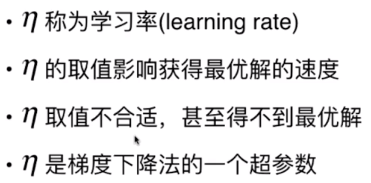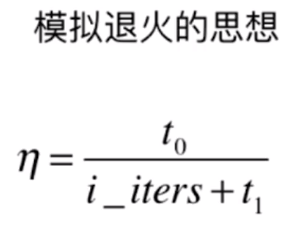文章目录
1,介绍
基本原理
梯度下降
不是一个机器学习的算法
是一个基于搜索的最优化方法
作用:最小化一个损失函数
梯度上升法:最大化一个效用函数

(不管在最低点哪一侧都会是,都会是下降的)
关于参数eta



并不是所有函数都有唯一的极值点

解决方法:
多次运行,随机化初始点
梯度下降法的初始值也是一个超参数
2,代码实现
会用到的库
import numpy as np
import matplotlib.pyplot as plt
原材料
首先建立一个简单的数据
# [-1,6]的等差数列,包含141个数值
plot_x = np.linspace(-1, 6, 141)
不同的算法会有不同的损失函数
# 损失函数
plot_y = (plot_x-2.5)**2-1
def J(theta):
return (theta-2.5)**2-1
大概长成这个样子
plt.plot(plot_x,plot_y)
plt.show()

损失函数求导
def dJ(theta):
return 2*(theta-2.5)
简单地梯度下降
eta:参数eta
epsilon:精度(不能保证刚好能取到最低点,所以当临近两次结果差值小于精度时停止)
theta_history:所有的损失值
theta:起始点
eta = 0.1
epsilon = 0.01
theta_history = [theta]
theta = 0.0
while True:
gradient = dJ(theta)
last_theat = theta #为了进行对比需要存储上一个损失值
theta = theta - eta*gradient
theta_history.append(theta)
if (abs(J(theta) - J(last_theat)) < epsilon):
break
print(theta)
print(J(theta))
plt.plot(plot_x,J(plot_x))
plt.scatter(np.array(theta_history),J(np.array(theta_history)),color='r',marker='+')
plt.show()
>>>2.499891109642585
>>>-0.99999998814289

下降了15次
len(theta_history)
>>>15
3,简单地封装一下
class Gradient_Descent:
def __init__(self, x, y):
self.theta_history = None
self.x = x
self.y = y
# 损失函数求导
def _dJ(theta):
return 2 * (theta - 2.5)
# 损失函数(根据不同算法是会变的)
def _J(theta):
return (theta - 2.5) ** 2 - 1
def gradinet_descent(self,initial_theta, eta, n_iters=100, epsilon=1e-8):
"""
:param initial_theta: 起始值
:param eta: 每次下降的步幅
:param n_iters: 最大下降次数,以防eta过大导致无限循环
:param epsilon: 精度
"""
theta = initial_theta
self.theta_history.append(initial_theta)
i_iters = 0
while i_iters < n_iters:
gradient = self._dJ(theta)
last_theat = theta
theta = theta - eta * gradient
self.theta_history.append(theta)
if abs(self._J(theta) - self._J(last_theat)) < epsilon:
break
i_iters += 1
def plot_theta_history(self):
"""
观察下降走势
:return:
"""
plt.plot(self.x, self._J(self.x))
plt.plot(np.array(self.theta_history), self._J(np.array(self.theta_history)), color='r', marker='+')
plt.show()
关于参数
eta的大小对回归的影响
1,当eta很小时,下降步幅会很小,从而我们的得到的theta_history会更大
eta = 0.01
theta_history = []
gradinet_descent(0.,eta)
plot_theta_history()

len(theta_history)
>>>424
2,当eta大的合理时,会发现他不一定只从单边下降,会跳点的
eta = 0.8
theta_history = []
gradinet_descent(0.,eta)
plot_theta_history()

3,当eta大的离谱时,函数就会报错
eta = 1.1
theta_history = []
gradinet_descent(0.,eta)
plot_theta_history()
>>>OverflowError: (34, 'Result too large')
我们也就需要有n_iters来限定下降次数
eta = 1.1
theta_history = []
gradinet_descent(0.,eta,n_iters=100)
plot_theta_history()

所以,当eta过大时,也会有可能是越来越大的,如上图(就很离谱)
当然,也刚好可能很巧和x轴平行(我就不尝试了,8年老本实在太慢)
4,多元线性回归中的梯度下降法
公式理解
即使在一元线性回归中sta都会有两个值【sta0=1,sta1】
再对每一项进行偏微分

举个例子,这是一个等高线的梯度下降法是意图
其中z为损失函数ste集包含[x, y]

得出多元线性回归的损失函数

再计算出每一项的梯度值(计算每一项偏导数)
通过公式可以看出来,每一项的大小和样本数量m有关,当m越大时,梯度值也会随之变大(就很离谱)
并不是所有的损失函数都可以直接用来进行梯度下降,有时需要特殊化

所以在下边会使用下列的J(sta)来计算梯度值

代码实现
首先需要有基本数据(先不用sklearn中的数据)
x:随机浮点数,浮点数范围 : (0,1),共100个
y:100个正态分布[normal]的数值
x = 2 * np.random.random(size=100).reshape(-1,1)
y = x * 3. + 4. + np.random.normal(size=100)
x.shape
>>>(100, 1)
y.shape
>>>(100, )
plt.scatter(x,y)
plt.show()

根据公式得到损失函数及其导数函数
theta:
x_b:
y:真值
def J(theta, x_b, y):
try:
return np.sum((y - x_b.dot(theta))**2) / len(x_b)
except:
return float('inf')
def dJ(theta, x_b, y):
res = np.empty(len(theta))
res[0] = np.sum(x_b.dot(theta) - y)
for i in range(1,len(theta)):
res[i] = (x_b.dot(theta) - y).dot(x_b[:,i])
return res * 2 / len(x_b)
np.empty(shape,[ dtype, order])
依据给定形状和类型(shape,[dtype, order])返回一个新的空数组。
def gradinet_descent(x_b, y, initial_theta, eta, n_iters = 100, epsilon=1e-8):
theta = initial_theta
i_iters = 0
while i_iters < n_iters:
gradient = dJ(theta, x_b, y)
last_theat = theta
theta = theta - eta * gradient
if (abs(J(theta, x_b, y) - J(last_theat, x_b, y)) < epsilon):
break
i_iters += 1
return theta
看一下效果
x_b = np.hstack([np.ones((len(x), 1)) ,x.reshape(-1,1)])
initial_theta = np.zeros(x_b.shape[1])
eta = 0.01
gradinet_descent(x_b, y, initial_theta, eta)
>>>array([3.21783895, 3.52422368])
使用向量化计算进行封装
先看一下公式吧(不管看得懂看不懂的)

这边我直接把它加在线性回归函数里了
方法:fit_gd()
import numpy as np
class LinearRegression:
def __init__(self):
self.coef_ = None # 系数
self.interception_ = None # 截距
self._theta = None # 回归系数矩阵
def fit_normal(self, x_train, y_train):
assert x_train.shape[0] == y_train.shape[0], "数据集有问题"
x_b = self._data_arrange(x_train)
self._theta = np.linalg.inv(x_b.T.dot(x_b)).dot(x_b.T).dot(y_train)
self.interception_ = self._theta[0]
self.coef_ = self._theta[1:]
return self
def fit_gd(self, x_train, y_train, eta=0.01, n_iters=1e4):
"""
使用数据归一化训练线性回归算法
:param x_train:
:param y_train:
:param eta: 步幅
:param n_iters: 最大循环次数
:return:
"""
assert x_train.shape[0] == y_train.shape[0], "error"
def J(theta, x_b, y):
try:
return np.sum((y - x_b.dot(theta)) ** 2) / len(x_b)
except:
return float('inf')
def dJ(theta, x_b, y):
return x_b.T.dot(x_b.dot(theta) - y) * 2 / len(x_b)
def gradinet_descent(x_b, y, initial_theta, eta, n_iters=100, epsilon=1e-8):
theta = initial_theta
i_iters = 0
while i_iters < n_iters:
gradient = dJ(theta, x_b, y)
last_theat = theta
theta = theta - eta * gradient
if abs(J(theta, x_b, y) - J(last_theat, x_b, y)) < epsilon:
break
i_iters += 1
return theta
x_b = self._data_arrange(x_train)
initial_theta = np.zeros(x_b.shape[1])
self._theta = gradinet_descent(x_b, y_train, initial_theta, eta, n_iters)
self.interception_ = self._theta[0]
self.coef_ = self._theta[1:]
return self
def _data_arrange(self, data):
return np.hstack([np.ones((len(data), 1)), data])
def predict(self, x_predict):
new_x_predict = self._data_arrange(x_predict)
return new_x_predict.dot(self._theta)
def score(self, x_test, y_test):
"""
使用 R Square的方法进行评估
:param x_test:
:param y_test:
:return: 跑分咯
"""
y_predict = self.predict(x_test)
mse = np.sum((y_predict - y_test) ** 2) / len(y_test)
return 1 - mse / np.var(y_test)
def __repr__(self):
return "多元线性回归"
5,使用梯度下降法训练回归算法
数值归一化(数据标准化)
使用梯度下降训练归一化,必须要先进行数值归一化
from sklearn.preprocessing import StandardScaler
std = StandardScaler()
std.fit(x_train)
>>>StandardScaler(copy=True, with_mean=True, with_std=True)
x_train_standard = std.transform(x_train)
x_test_standard = std.transform(x_test)
训练算法
lin_reg2 = LinearRegression()
%time lin_reg2.fit_gd(x_train_standard,y_train)
>>>Wall time: 262 ms
多元线性回归
lin_reg2.score(x_test_standard,y_test)
>>>0.803783326319831
使用梯度下降的优点
速度贼快~
6,随机梯度下降法
理解

模拟退火的思想

代码实现
def dJ_sgd(theta, x_b_i, y_i):
return x_b.T.dot(x_b.dot(theta) - y_i) * 2
def sgd(x_b, y, initial_theta, n_iters):
t0 = 5
t1 = 50
def learning_rate(t):
return t0/(t+t1)
theta = initial_theta
for cur_iter in range(n_iters):
rand_i = np.random.randint(len(x_b))
gradinet = dJ_sgd(theta,x_b[rand_i],y[rand_i])
theta = theta - learning_rate(cur_iter) * gradinet
return theta
%%time
x_b = np.hstack([np.ones((len(x), 1)) ,x])
initial_theta = np.zeros(x_b.shape[1])
theta = sgd(x_b, y, initial_theta,n_iters=len(x_b)//3)
>>>Wall time: 110 ms
使用sklearn中的SGD方法
只能解决线性模型
from sklearn.linear_model import SGDRegressor
sgd_reg = SGDRegressor()
%time sgd_reg.fit(x_train_standard,y_train)
sgd_reg.score(x_test_standard,y_test)
>>>Wall time: 260 ms
0.7938286715532883
7,关于梯度调试
图示及公式理解


代码实现
先创建一组数据以供给使用
np.random.seed(666)
x = np.random.random(size=(1000,10))
true_theta = np.arange(1,12,dtype=float)
x_b = np.hstack([np.ones((len(x),1)),x])
y = x_b.dot(true_theta) + np.random.normal(size=1000)
def J(theta, x_b, y):
try:
return np.sum((y - x_b.dot(theta))**2) / len(x_b)
except:
return float('inf')
def dJ_math(theta, x_b, y):
return x_b.T.dot(x_b.dot(theta) - y) * 2. / len(x_b)
def dJ_debug(theta, x_b, y, epsilon=0.01):
res = np.empty(len(theta))
for i in range(len(theta)):
theta_1 = theta.copy()
theta_1[i] += epsilon
theta_2 = theta.copy()
theta_2[i] -= epsilon
res[i] = (J(theta_1, x_b, y) - J(theta_2, x_b, y)) / (2*epsilon)
return res
def gradinet_descent(dJ, x_b, y, initial_theta, eta, n_iters = 100, epsilon=1e-8):
theta = initial_theta
i_iters = 0
while i_iters < n_iters:
gradient = dJ(theta, x_b, y)
last_theat = theta
theta = theta - eta * gradient
if (abs(J(theta, x_b, y) - J(last_theat, x_b, y)) < epsilon):
break
i_iters += 1
return theta
使用
x_b = np.hstack([np.ones((len(x),1)),x])
initial_theta = np.zeros(x_b.shape[1])
eta = 0.01
%time theta = gradinet_descent(dJ_debug, x_b, y, initial_theta, eta)
>>>Wall time: 50 ms
8,总结
批量梯度下降法
需要对每一个数据进行梯度下降
优点:稳定,一定可以向损失函数下降最快的方向前进
缺点:速度慢,在每一次都需要对所有的样本看一遍
随机梯度下降法
每次只看一个样本
优点:速度快,每次只看一个样本
缺点:不稳定,每一次的方向是不确定的(有可能相反方向前进)
关于随机↓

小批量梯度下降法
综合上边的优点,每次看 k 个样本
例如:一次看10个样本
相对灵活的取值
